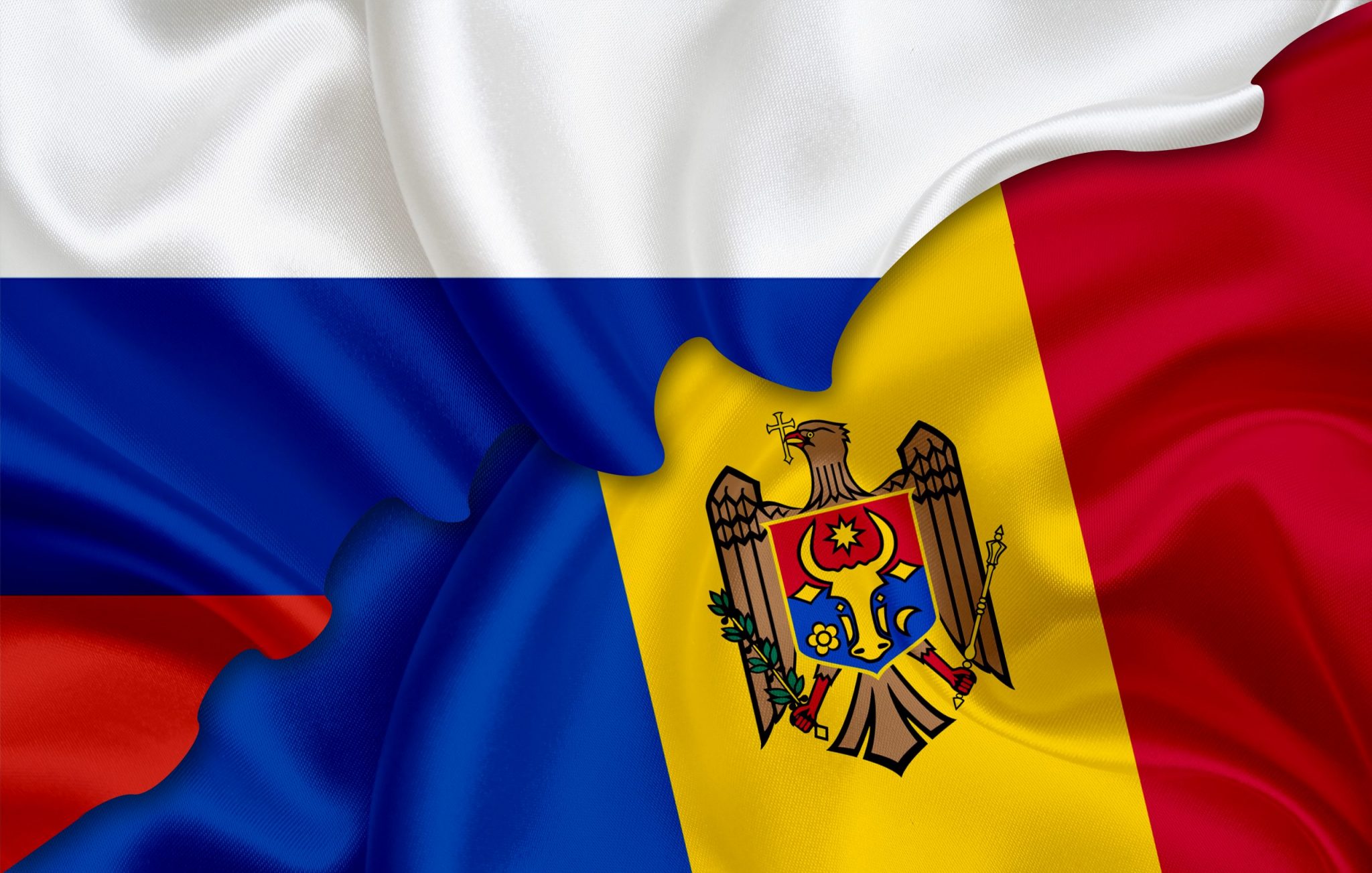In July, Moldovan Prime Minister Natalia Gavrilița said she feared that Russia could target Moldova next as it continues to wage its devastating war in Ukraine. From her statement, it seems likely that Moldova could become an increasingly significant country to watch as the conflict evolves. Particularly if Russian troops move into the southwestern part of Ukraine, Moldova faces a unique threat of conflict spillover due to its proximity to Ukraine, and an expansion of the conflict could further deteriorate the security of the broader region, which is already overburdened by the refugee crisis and other consequences of the war.
Furthermore, rising tensions in Transnistria carry the risk of inadvertent escalation. Transnistria is a contested territory between Moldova and Russia with a majority Russian population. It declared its independence in an attempt to remain a part of the Soviet Union when Moldova broke off. This declaration resulted in a two-year war between Moldova and Transnistria that ended in a ceasefire, which established a Russian peacekeeping force in the region that still exists to this day. Transnistria continues to be controlled by pro-Russian separatists and tensions have recently flared in the region due to Russia’s war in Ukraine, with a string of attacks on government infrastructure occurring in April 2022.
As a result, inadvertent escalation is increasingly likely as Moldova’s EU candidacy puts into question the future of Transnistria’s status. Moldova’s EU candidacy could further aggravate the territorial dispute around Transnistria, since the bloc is unlikely to accept an unstable country and separatists could use that fact as justification and motivation to move toward independence. Therefore, it is useful to analyze how Russian media has been talking about Moldova since the war began to understand how Moldova may factor into Russia’s foreign policy strategy.
Hamilton 2.0 data shows that Russian media and government accounts have mentioned Moldova and/or Transnistria more than 1,300 times on Twitter since Russia’s war in Ukraine began on February 24, 2022. An analysis of Russian media sites and tweets showed that Russia’s messengers are pushing four main narratives around Moldova: Ukraine and the West want to drag Moldova into a conflict; Transnistria is like the Donbas; Romania is seeking a way to reunify with or absorb Moldova; and Moldova is becoming a corrupt, anti-Russian Western pawn.
Ukraine and the West Want to Drag Moldova into a Conflict
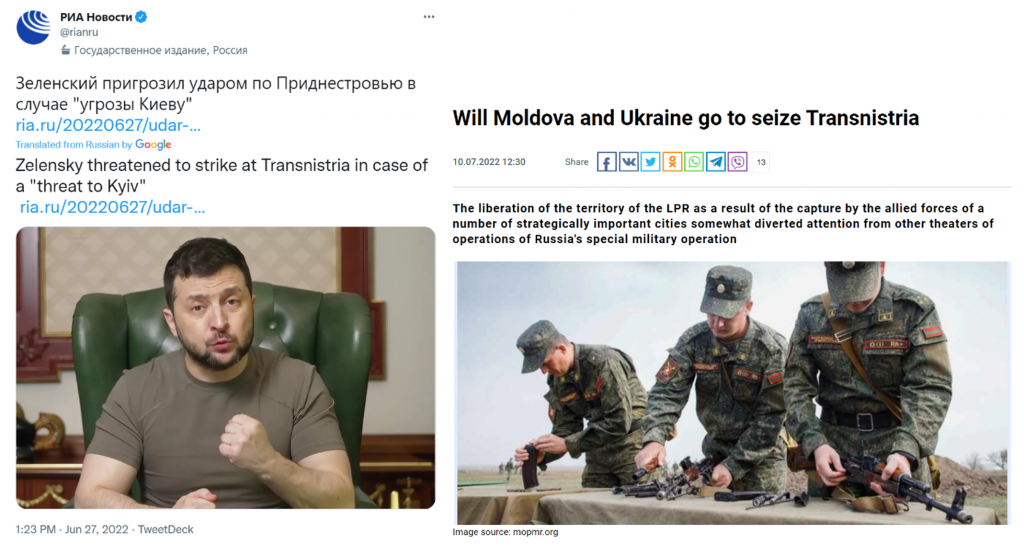
The Kremlin’s claims about the prospect of Moldova being dragged into the ongoing conflict largely center around the idea that the Armed Forces of Ukraine may open a military front in Transnistria. Russian state media has argued that Ukraine and Moldova may be actively planning an incursion into the territory either by creating a pretext to invade or responding to escalatory events in Transnistria, citing evidence such as the shelling of Transnistria’s Ministry of State Security, the bombing of radio towers in the village of Mayaki, and cases of Ukrainian drone flights over Transnistria. However, the perpetrators who bombed these sites still remain unknown, and the drones that flew over Transnistria were not verifiable as Ukrainian drones. In response to this scenario, the Kremlin has stated that it is closely monitoring the situation and that, while Russia supports peace in the region, its military would be forced to respond if Ukraine or Moldova led an incursion into the region.
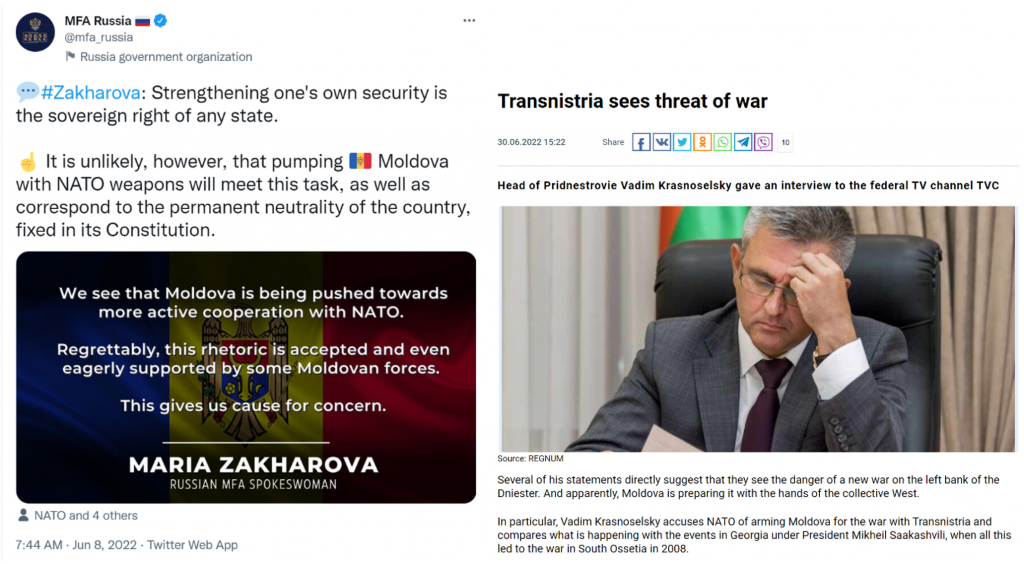
Russian officials and state media further contend that the West would support Ukraine and Moldova in this effort, primarily arguing that NATO may be supplying weapons to Moldova to support military action in Transnistria. Both Russian officials and state media outlets have made this claim numerous times without evidence, and Russian state media situate this narrative within NATO’s broader strategy to counterbalance Russia and aid Ukraine in the war. For example, Newsfront—a Crimea-based news outlet with links to Russia’s Federal Security Service—published articles in late June and early July that warned against the potential implications of NATO’s support to Moldova and possible aid to a war in Transnistria. These potential actions by NATO include the opening of military bases on Moldovan soil or even the deployment of foreign troops to Moldova to aid with the developing situation in Transnistria.
Transnistria Is Like the Donbas
The third narrative that Russian media is pushing is that Transnistria is comparable to the Donbas region of Ukraine. Russia media outlets like Newsfront and Tass continuously emphasize the discontent of Transnistria’s population with the Moldovan government. Articles and tweets on Transnistria have referenced its history under the Russian Empire and the Soviet Union, projecting the idea that Transnistrians lived peacefully while under Russian control but have faced war and instability since official control of the territory was transferred to Moldova upon its independence. Russian media has denoted Moldova’s loss of authority in Transnistria as “Moldova’s Crimea.” State media has also highlighted that Transnistria is still part of the Russian sphere of influence, but the Kremlin has not officially recognized Transnistria’s stated desire for integration with Russia.
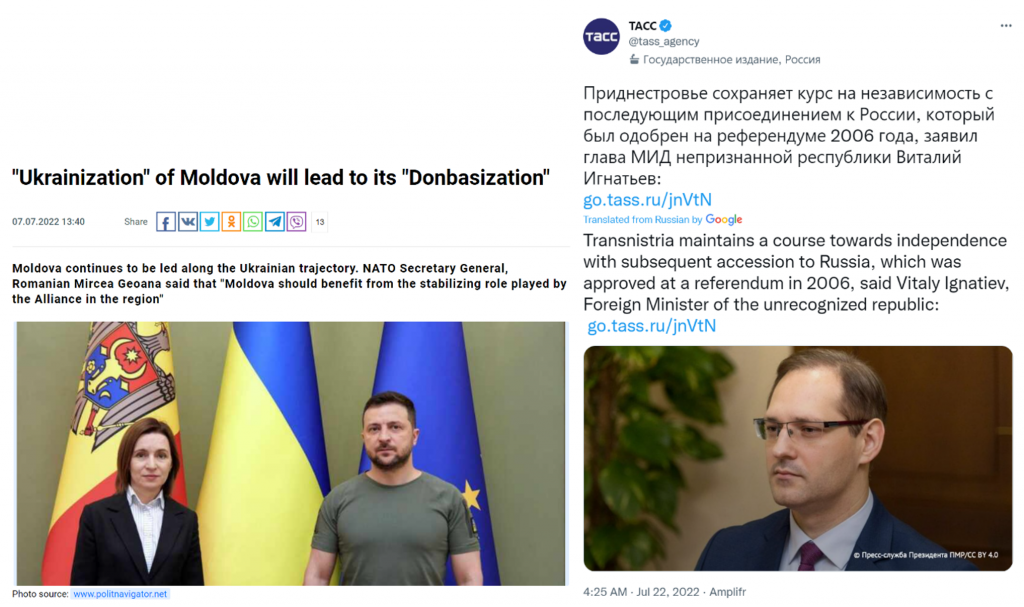
Romania Is Seeking A Way to Reunify With or Absorb Moldova
RT and other Russian state-backed outlets also made the claim that Moldova and Romania may reunify through a voluntary process that Romania is spearheading. State media largely has amplified the former pro-Russian president of Moldova Igor Dodon’s comments on how the Moldovan government could be planning to hold a referendum on reunification with Romania, despite the lack of any action or rhetoric by Moldovan officials on the issue and the fact that Moldova is now on the path to EU accession. Most of these outlets contend that Romania is pushing for reunification to achieve its strategic ambitions in the region—notably, to help NATO project its influence in Russia’s near abroad.
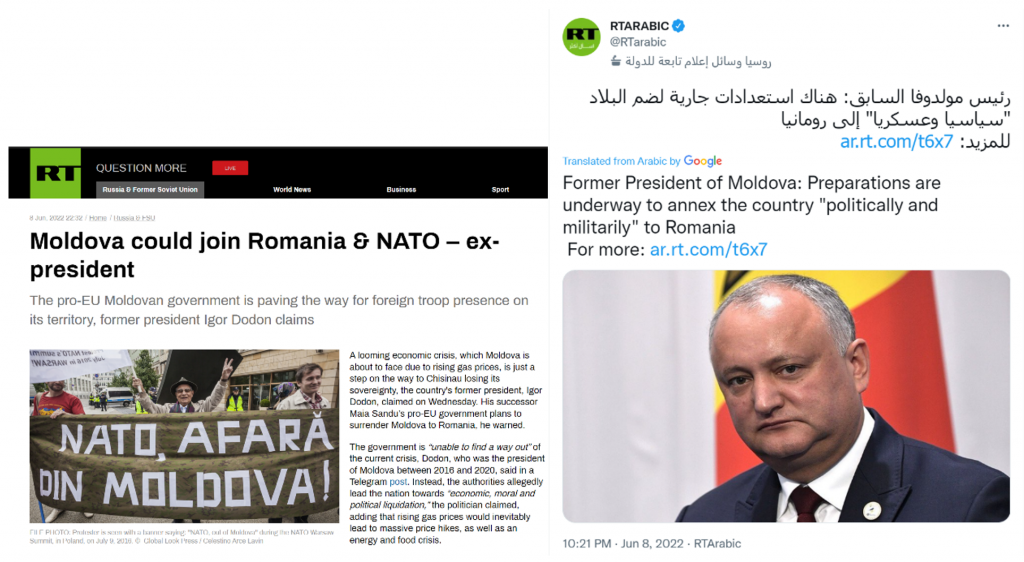
Russian state media and officials additionally highlighted polls that suggest low support in Moldova for reunification, insinuating that the Moldovan government may pursue reunification against the will of its people and, particularly, against the will of those who live in Transnistria. Moldovan officials are also portrayed as puppets of Romania because many are also Romanian citizens. Russian media’s assertions are likely intended to push the idea that if there is considerable action on reunification, Russia could have justification to intervene in Transnistria or in other parts of Moldova on the basis that the government is preventing self-determination. This is a comparable narrative to that which Russia pushes about corruption within Ukraine’s government. Moldovan President Maia Sandu recently said, “Moldova’s unification with Romania would be possible if citizens wanted it.” As there has been a noted increase in support for reunification in public opinion polls, action on reunification could be more likely than it was before the war and may provoke an aggressive response from Russia.
Moldova Is Becoming A Corrupt, Anti-Russian Western Pawn
Russian state media and government officials further contend that Moldova is becoming a Western pawn due to the government’s pro-EU agenda and path to EU accession. Russia’s messengers portray Moldova’s government as being controlled by Western leaders who wish to “use Moldovans as cannon fodder in the geopolitical battle that is currently unfolding in the region.” State media and government officials explain Moldova’s consent to Western influence as being motivated by its desire to join the EU and to gain political leverage over Moscow on issues such as gas prices.
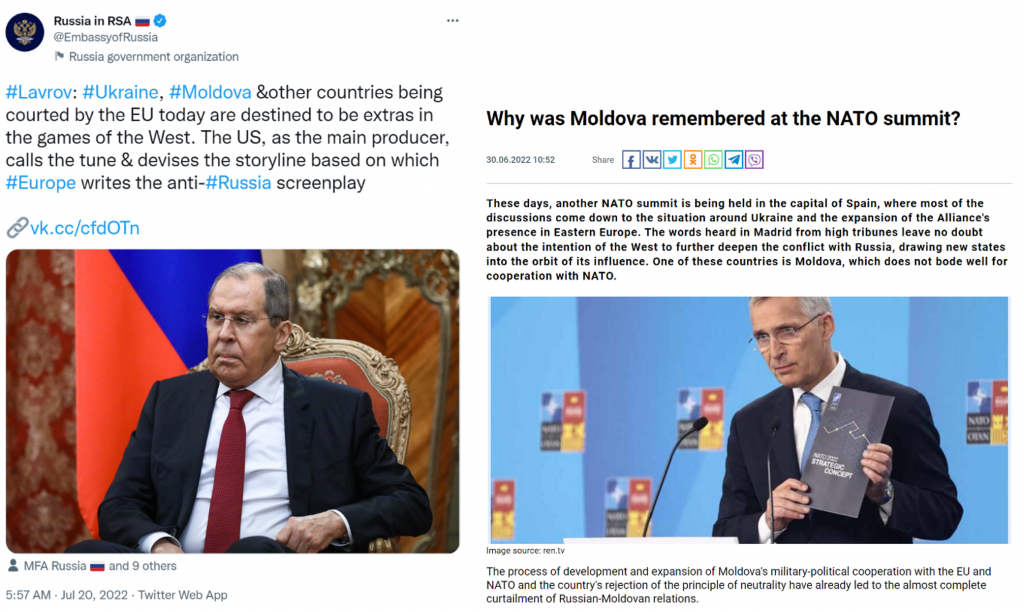
Beyond Western control, Russian media have contested that the Sandu administration is heavily corrupt and dictatorial. State media outlets argue that Moldova is eliminating any pro-Russian political opposition and that Moldova’s attempts to prohibit war propaganda are biased and evidence of Russophobia.
Why It Matters
Russian state media’s inflated rhetoric shows that Moscow views the developments in Moldova and Transnistria as broadly threatening to its foreign policy objectives in the region, including its progress in the Ukraine war if a second front is opened in Transnistria and its ability to maintain political leverage and influence in Moldova. The four main narratives on Moldova are centered around the common themes that Moldova is moving away from Russia and that there are important and serious developments in Moldova’s foreign policy, such as its pivot to the West and reconsideration of reunification with Romania, that could profoundly impact Russia’s strategy in the region.
As with Ukraine, the projection of these narratives could indicate that Moldova is vulnerable to Russian intervention in some capacity. Russian foreign policy officials have supported or referenced many of these narratives by retweeting posts or tweeting statements that project many of the claims detailed above. As a result, exploring these narratives and the potential strategic motivations behind them can provide insight into how Russia may view and react to developments in Moldova and Transnistria in the near future. Throughout the duration of the war in Ukraine and in the years after, it will become increasingly important to monitor Russia’s influence in the country, particularly as Moldova’s EU integration progresses or tensions in Transnistria rise.
The views expressed in GMF publications and commentary are the views of the author alone.

